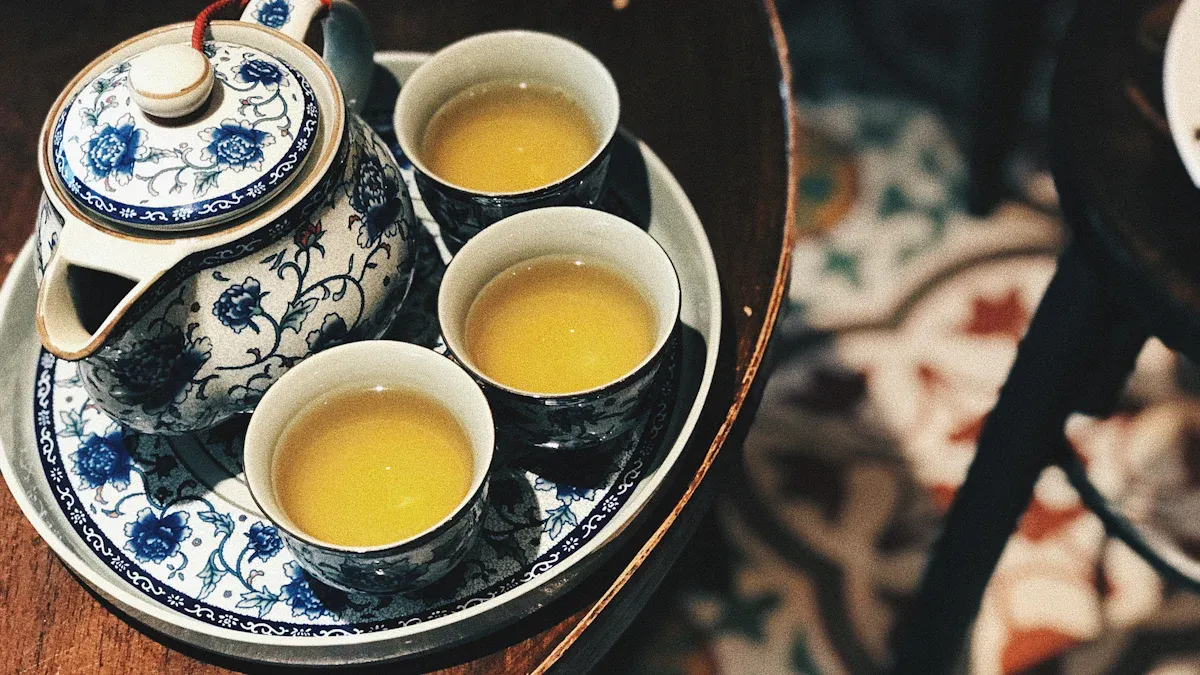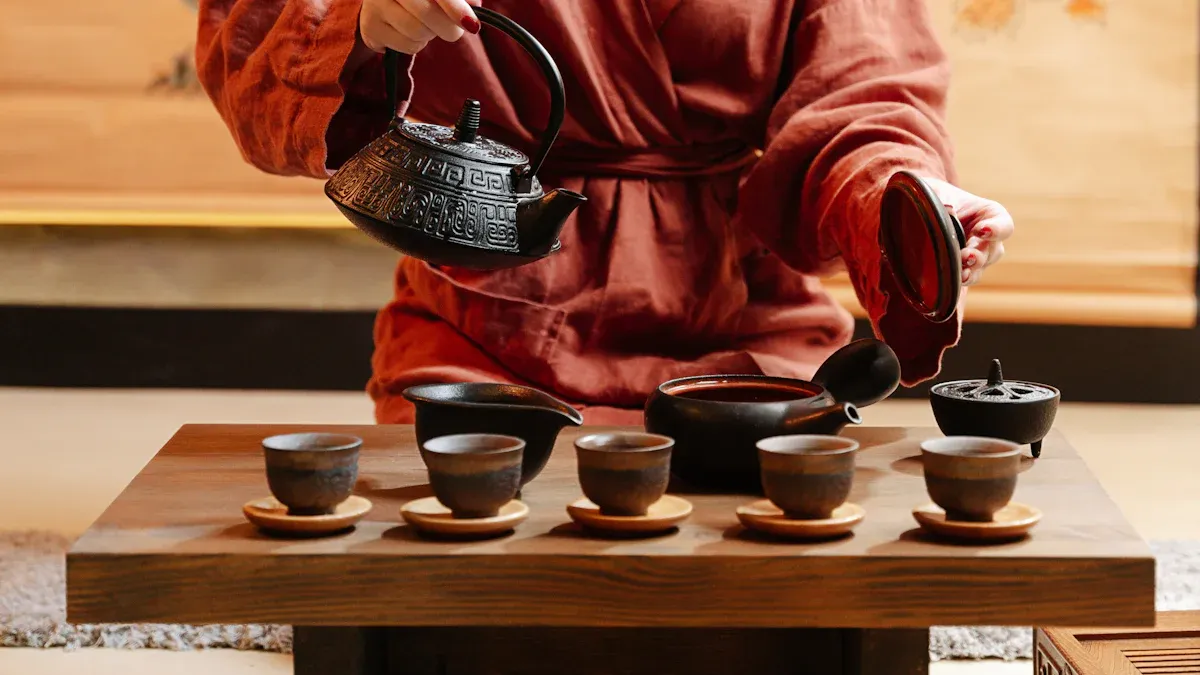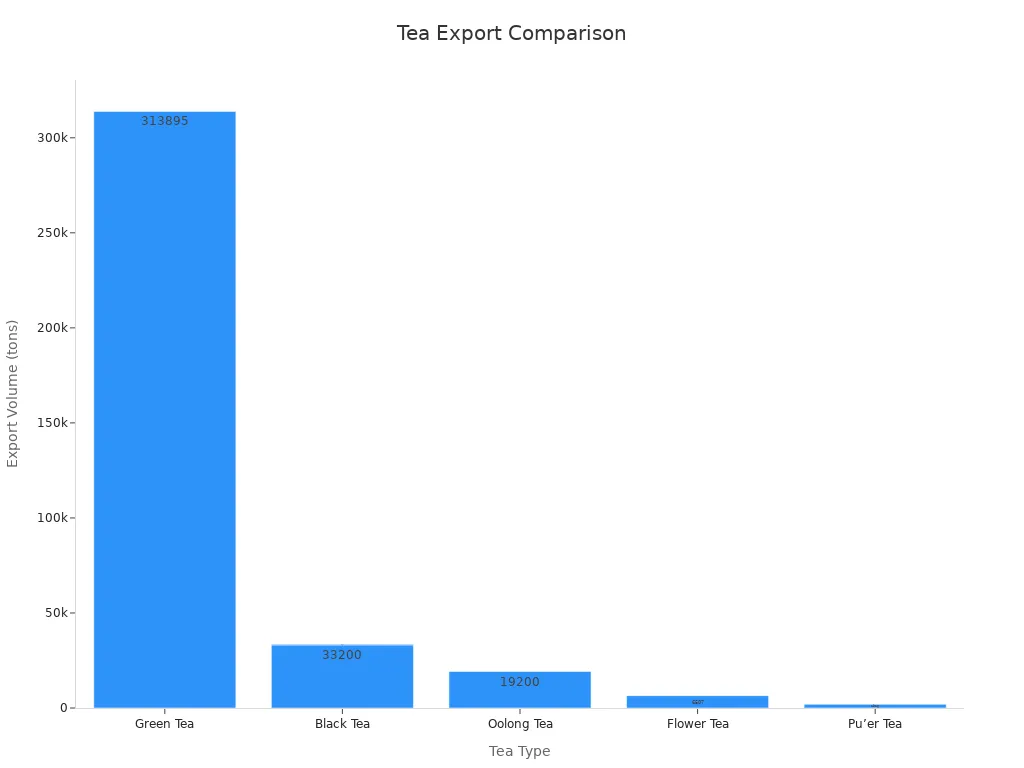Why Chinese Tea Is Loved Worldwide
Chinese tea holds a special place in the hearts of tea lovers around the globe. Its roots trace back over 2,000 years, with early cultivation in regions like Chang’an during the Western Han Dynasty. By 200 CE, tea began traveling Central Asia’s trade routes, eventually reaching the Silk Road. You can still see its influence today in global markets: green tea dominates China's exports at 84.2%, while countries like Ghana have increased imports by 44%. This enduring legacy showcases how Chinese tea blends history, culture, and taste into every cup.
Key Takeaways
- Chinese tea has been important for over 2,000 years.
- The Silk Road helped share Chinese tea with the world.
- It became a sign of wealth and cultural sharing.
- Different types like green, black, and oolong have special tastes.
- These flavors come from local skills and old methods.
- Drinking Chinese tea can help with digestion and heart health.
- It may also support brain function and thinking clearly.
- The Gongfu Tea Ceremony shows the beauty of making tea.
- It focuses on being mindful and honoring old traditions.
Rich History and Cultural Significance

The Silk Road and the Global Spread of Chinese Tea
The Silk Road played a vital role in introducing Chinese tea to the world. This ancient trade route connected China to regions as far as Europe, the Middle East, and Africa. Alongside silk and porcelain, tea became one of the most sought-after commodities. Merchants transported it across deserts and mountains, making it a symbol of luxury in foreign lands. Wealthy elites in Persia and the Roman Empire eagerly embraced this exotic beverage, drawn to its unique flavor and cultural significance. The Silk Road not only spread tea but also brought valuable goods like spices and gemstones into China, fostering a two-way exchange that enriched both sides.
As global trade expanded, key historical events marked the rise of Chinese tea in international markets:
- 1685 CE: England began trading directly with China, importing tea from the Amoy region.
- 1689 CE: The Trade Treaty of Newchinsk opened trade routes between China and Russia, increasing tea's popularity in Russian society.
- 1707 CE: Thomas Twinning added tea to the menu at his London coffeehouse, boosting its appeal in England.
- 1773 CE: The Boston Tea Party highlighted tea's political importance, leading to significant changes in America.
- 1789 CE: Post-American Revolution, America started trading directly with China, ending England's monopoly on tea imports.
These milestones illustrate how Chinese tea became a global phenomenon. Its journey from the fields of China to the tables of Europe and beyond reflects its enduring appeal. Today, when you sip a cup of tea, you participate in a tradition shaped by centuries of trade and cultural exchange.
Diverse Varieties and Unique Flavors
The Art of Scenting and Blending Chinese Tea
When you explore Chinese tea, you’ll notice that its diversity goes beyond just green, black, or oolong. The artistry of scenting and blending plays a crucial role in creating the unique flavors that tea enthusiasts cherish. This process combines traditional techniques with regional expertise, resulting in teas that are as varied as the landscapes they come from.
Scenting tea involves infusing it with the natural fragrance of flowers, fruits, or herbs. Jasmine tea, one of the most famous scented teas, is made by layering fresh jasmine blossoms over tea leaves. The blossoms are replaced multiple times to ensure the tea absorbs their delicate aroma. This meticulous process creates a harmonious balance between the floral scent and the tea’s natural flavor. Similarly, osmanthus-scented tea offers a sweet, fruity fragrance that pairs beautifully with lighter tea varieties.
Blending, on the other hand, focuses on combining different tea leaves or adding ingredients like dried fruits, spices, or even edible flowers. This technique allows tea masters to craft unique flavor profiles tailored to specific preferences. For example, a blend of black tea with dried orange peel and cinnamon creates a warm, spiced flavor perfect for winter. These blends not only enhance the taste but also add visual appeal, making the tea experience more enjoyable.
The regional differences in Chinese tea varieties further enrich this diversity. Each province brings its own signature flavors to the table:
- Fujian Province: Famous for Oolong teas like Rock Tea and Iron Goddess, as well as White Teas such as Bai Mudan and Silver Needle.
- Yunnan Province: Known for Pu-erh tea, which undergoes aging and fermentation to develop complex, earthy flavors.
- Zhejiang Province: Renowned for Longjing (Dragon Well) tea, a green tea prized for its nutty and delicate taste.
- Anhui Province: Celebrated for Keemun black tea, which offers floral and fruity notes.
- Hunan Province: Home to Anhua dark tea, a fermented tea with a rich, mellow flavor.
The unique flavors of Chinese tea are not just a result of blending and scenting but also the environment where the tea grows. In Yunnan, for instance, the soil’s pH levels range from 4.45 to 5.16, providing optimal conditions for tea cultivation. This variation in soil quality contributes to the distinct taste profiles of teas from different regions.
Modern consumer preferences also reflect the growing appreciation for these unique flavors. Surveys show that people enjoy innovative combinations, such as milk tea with cream cheese, for its rich texture and balanced taste. Brands like Heytea and Mixue Bingcheng have capitalized on this trend, offering high-quality ingredients and creative blends that appeal to younger audiences. The rise of new Chinese tea drinks highlights the endless possibilities of blending tradition with innovation.
Botanical studies further reveal the complexity of Chinese tea flavors. Using advanced techniques like gas chromatography-mass spectrometry (GC-MS), researchers have identified the aromatic compounds that define teas like Phoenix Dancong. These studies show how scenting and blending enhance the natural characteristics of tea, creating a sensory experience that’s both timeless and modern.
When you sip a cup of Chinese tea, you’re not just enjoying a beverage. You’re experiencing centuries of craftsmanship, regional expertise, and a deep connection to nature. Whether it’s a floral-scented green tea or a bold, spiced blend, each cup tells a story of tradition and innovation.
Health Benefits of Chinese Tea
Benefits for Digestion, Heart, and Mind
Chinese tea offers remarkable health benefits that support your digestion, heart, and mind. Its natural compounds, such as catechins and polyphenols, contribute to these effects, making it a valuable addition to your daily routine.
Digestive Health
Drinking Chinese tea can improve your digestion by promoting the breakdown of fats and aiding nutrient absorption. Green tea, for instance, contains catechins that stimulate digestive enzymes, helping your body process food more efficiently. Additionally, Pu-erh tea, known for its fermentation process, supports gut health by encouraging the growth of beneficial bacteria. This makes it an excellent choice after heavy meals.
Cardiovascular Wellness
Chinese tea plays a significant role in maintaining heart health. Studies show that regular tea consumption reduces the risk of cardiovascular diseases. For example, habitual tea drinkers have a 20% lower risk of heart disease and a 22% lower risk of fatal heart conditions. Green tea catechins also help manage weight and glucose levels, reducing factors that contribute to heart disease.
Cognitive Benefits
Chinese tea also supports your mental health. Drinking tea regularly can reduce the risk of cognitive disorders. For every 100 ml/day increase in tea consumption, the risk decreases by 6%, and for 500 ml/day, the reduction reaches 29%. This makes tea a powerful ally in maintaining mental sharpness as you age.
- Daily tea drinkers among the oldest-old Chinese had a significantly reduced risk of mortality (HR, 0.90; 95% CI 0.84–0.96) compared to non-tea drinkers.
- Tea consumption is inversely associated with cognitive disorders, with risk reductions of 6%, 19%, and 29% for every 100 ml/day, 300 ml/day, and 500 ml/day increase in consumption, respectively.
By incorporating Chinese tea into your lifestyle, you can enjoy its benefits for digestion, heart health, and mental clarity. Whether you choose green tea, Pu-erh, or another variety, each cup contributes to your overall well-being.
Art and Rituals of Chinese Tea Preparation

The Gongfu Tea Ceremony
The Gongfu Tea Ceremony, a cornerstone of Chinese tea culture, showcases the artistry and mindfulness behind tea preparation. Originating during the Ming Dynasty, this ritual emphasizes precision, aesthetics, and the harmonious interaction between tea, teaware, and the individual. The term "Gongfu" translates to "skill" or "effort," reflecting the care and expertise required to perform this ceremony.
The ceremony begins with selecting high-quality loose-leaf tea, often oolong or pu-erh, and pairing it with elegant teaware. A small clay teapot, known as a Yixing teapot, is commonly used due to its ability to enhance the tea's flavor over time. The process involves multiple steps, each performed with deliberate movements. You rinse the teapot and cups with hot water to warm them, then add the tea leaves and pour water at the ideal temperature. The first brew, often called the "awakening of the leaves," is discarded to cleanse the tea. Subsequent infusions are served in small cups, allowing you to savor the evolving flavors with each pour.
The Gongfu Tea Ceremony is more than a method of brewing tea; it is a reflection of Chinese philosophy. Influences from Daoism, Confucianism, and Buddhism shape its principles, emphasizing simplicity, humility, and mindfulness. By engaging in this ritual, you connect with nature and cultivate a sense of inner peace.
Over time, the ceremony has evolved while retaining its traditional essence. During the Qing Dynasty, it became more refined, with a greater focus on teaware variety and ritualistic elements. Today, technological advancements and global interest have made Gongfu Cha accessible worldwide. Enthusiasts from different cultures now embrace this practice, appreciating its blend of tradition and artistry.
The Gongfu Tea Ceremony invites you to slow down and appreciate the intricate details of tea preparation. Each step, from the aroma of the leaves to the warmth of the cup in your hands, creates a sensory experience that connects you to centuries of Chinese tea tradition.
Global Influence and Modern Popularity
Chinese Tea’s Role in Global Tea Traditions
Chinese tea has profoundly influenced tea traditions worldwide, shaping cultural practices and ceremonies across continents. Its historical significance and unique preparation methods have inspired countless adaptations, making it a cornerstone of global tea culture.
Cultural studies reveal how tea evolved from a simple beverage into a symbol of social connection and respect. In imperial China, high-quality teas were reserved for emperors and nobility, reflecting their status and importance. This tradition of associating tea with respect continues today in ceremonies like the Chinese wedding tea ritual, where serving tea symbolizes gratitude and familial bonds. Similarly, the Japanese Chanoyu tea ceremony, rooted in Zen Buddhism, was heavily influenced by Chinese tea practices. Over time, it transformed into a sophisticated cultural performance embraced by Japan’s warrior class.
Anthropologists also highlight tea’s role in transmitting values across generations. In many Asian households, preparing and sharing tea fosters a sense of community and continuity. This cultural exchange extends beyond Asia. For instance, the Global Tea Initiative connects scholars and industry leaders worldwide, promoting the study of tea culture and science. Events like the Hangzhou International Tea Culture Expo, which attracted over 100,000 visitors in 2019, further demonstrate how Chinese tea fosters global appreciation and cultural exchange.
Chinese tea’s influence is not limited to traditions. It also plays a significant role in international trade. China remains the world’s largest tea producer, with an annual production of approximately 2.8 million metric tons in 2022. Major export markets include Europe, North America, and Asia, with countries like Russia, Germany, and the United States showing significant demand. This global reach underscores the enduring appeal of Chinese tea, both as a cultural artifact and a commercial product.
Modern-Day Appeal in Cafes and Homes
In today’s fast-paced world, Chinese tea has found a new audience among younger consumers and urban dwellers. Its versatility and health benefits make it a popular choice in cafes and homes, blending tradition with modern convenience.
Specialty tea cafes have emerged as hubs for tea enthusiasts, offering curated experiences that highlight the artistry of Chinese tea. These cafes often feature unique blends and innovative presentations, such as cold brews and bubble teas. Younger consumers, particularly those aged 18-34, are drawn to these modern interpretations. They value the convenience of ready-to-drink options and the creativity of customized flavors. For example, cold brew teas and sugar-free beverages appeal to health-conscious individuals seeking refreshing alternatives to sugary drinks.
At home, Chinese tea continues to thrive as a daily ritual. Consumers increasingly seek teas with specific health benefits, such as stress relief and immunity support. Organic and fair-trade teas are gaining popularity, reflecting a growing awareness of environmental and ethical concerns. The rise of online platforms has also made it easier for people to explore and purchase high-quality teas from the comfort of their homes.
The market data reflects this growing interest. According to IMARC Group, the global tea market is expected to reach $38.1 billion by 2030, with a compound annual growth rate (CAGR) of 4.5%. Ready-to-drink and specialty teas are driving this growth, catering to the evolving preferences of modern consumers. China’s tea exports also highlight this trend. In 2022, the country exported around 369,000 tons of tea, with green tea accounting for 83.6% of total exports. This dominance in the global market showcases the adaptability and enduring appeal of Chinese tea.

Whether enjoyed in a traditional ceremony or as a modern cold brew, Chinese tea continues to captivate people worldwide. Its ability to adapt to changing tastes while preserving its rich heritage ensures its place as a timeless beverage for generations to come.
Chinese tea continues to enchant tea lovers worldwide with its timeless charm. Its rich history, diverse flavors, and health benefits make it more than just a beverage—it’s a cultural treasure. Efforts to revitalize tea culture in China highlight its enduring global appeal. Despite competition from foreign brands, China remains a leader in producing high-quality teas. This revival reflects a deep sense of cultural pride, ensuring that Chinese tea remains relevant in modern times. When you enjoy a cup, you connect with a tradition that bridges cultures and celebrates shared moments.
FAQ
What makes Chinese tea different from other teas?
Chinese tea stands out due to its rich history, diverse varieties, and unique preparation methods. It offers a wide range of flavors, from earthy Pu-erh to floral Jasmine tea. The emphasis on tradition and craftsmanship makes it a cultural treasure.
How should you store Chinese tea to maintain its freshness?
Store Chinese tea in an airtight container, away from light, moisture, and strong odors. Keep it in a cool, dry place. For teas like green or white, refrigeration can help preserve their delicate flavors.
Can you reuse Chinese tea leaves?
Yes, you can reuse Chinese tea leaves multiple times. High-quality teas, like oolong or Pu-erh, often improve with subsequent brews. Each infusion reveals new layers of flavor, making the experience more enjoyable.
Is Chinese tea suitable for beginners?
Absolutely! Beginners can start with mild teas like Longjing (Dragon Well) or Jasmine tea. These teas offer approachable flavors and are easy to brew. Experimenting with different types helps you discover your preferences.
Does Chinese tea contain caffeine?
Yes, Chinese tea contains caffeine, but the amount varies by type. Green and white teas have lower caffeine levels, while black and Pu-erh teas contain more. If you're sensitive to caffeine, opt for lighter teas or enjoy them earlier in the day.
☕ Tip: Decaffeinated options are also available if you want to enjoy tea without caffeine.
